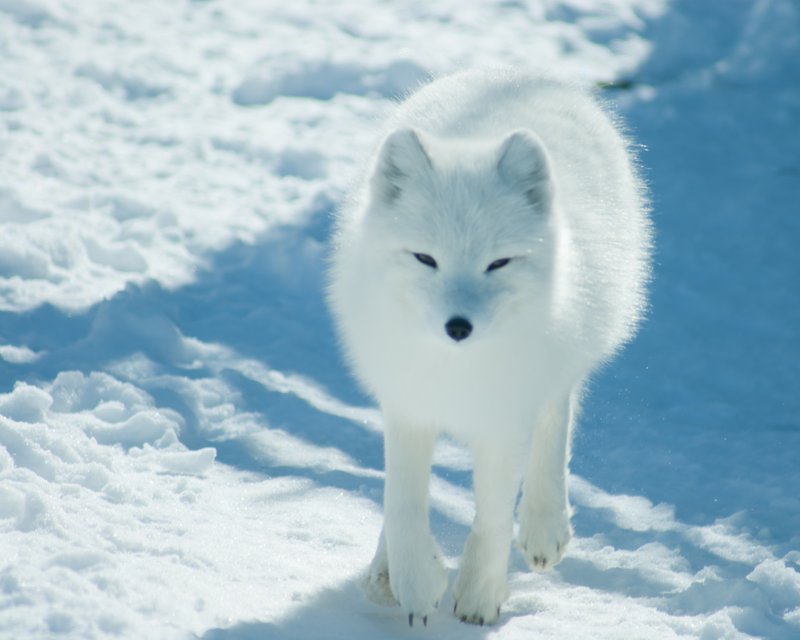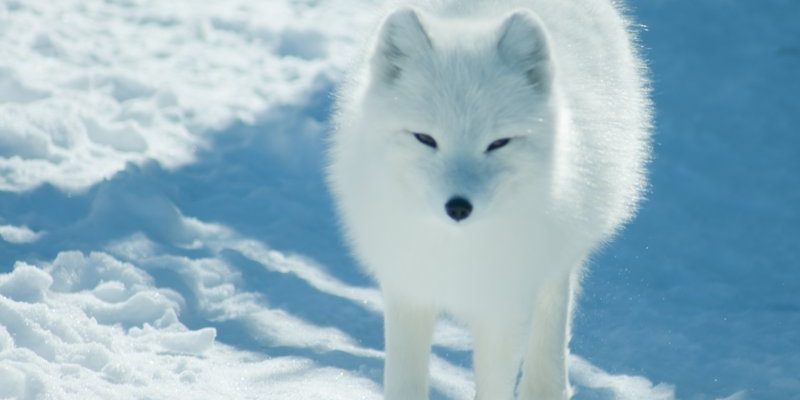
The Arctic fox is a master of its chilly domain. Its life is filled with remarkable traits and behaviors that help it thrive in extreme conditions. From its stunning fur color changes to its unique hunting strategies, the Arctic fox has more surprises than you might expect. Whether you’re a nature enthusiast or just curious about these amazing animals, let’s dive into the top 10 fascinating facts about the Arctic fox.
1. Adapted for Extreme Cold
Let’s start with what makes the Arctic fox truly remarkable: its ability to withstand the cold. The Arctic environment can drop to −58°F (−50°C), and yet, this little fox runs around like it’s a sunny day in the park. How does it do it? Well, the Arctic fox has a thick, warm coat made up of two layers. The undercoat is soft and fluffy, while the outer coat consists of longer guard hairs that repel moisture.
In addition to this cozy fur, the Arctic fox has furry pads on its feet that not only keep it warm but also help it grip the icy ground. Imagine wearing fuzzy slippers on a slippery floor—that’s how the Arctic fox navigates its surroundings. Thanks to these adaptations, the Arctic fox can roam freely through the snow and hunt for food even in the most frigid conditions.
2. Color Changing Fur
One of the most eye-catching features of the Arctic fox is its fur color. During the winter months, it has a stunning white coat that acts like a perfect camouflage against the snow. When summer arrives, the fox’s fur turns a brown or gray color, blending in with the rocky tundra. This seasonal change isn’t just beautiful; it’s also a brilliant survival tactic.
The color change happens due to a combination of genetics and environmental factors. Essentially, the fox’s body senses the change in temperature and daylight, signaling it to shed its winter coat. It’s like putting on a seasonal outfit to match the surroundings! This incredible ability to adapt not only protects it from predators but also enhances its hunting skills, as it can sneak up on prey without being easily spotted.
3. Incredible Hunters
The Arctic fox is a skilled hunter, and its strategy is quite clever. While it primarily feeds on small mammals like lemmings, it’s not picky. The fox will also munch on birds, eggs, and even carrion when necessary. One fascinating technique it uses is called “mousing.”
During this process, the fox listens carefully for the sounds of its prey under the snow. Once it zeroes in, it leaps high into the air and dives down to snatch up its meal. Imagine a snow-covered trampoline; the fox bounces off the surface, making hunting look almost like a playful game. This hunting style showcases its agility and keen senses, allowing it to thrive in a place where food can be scarce.
4. Unique Social Structure
You might think of foxes as solitary creatures, but the Arctic fox has a surprisingly social side. These foxes often form small family groups. A typical family unit includes a mated pair and their young. In these groups, everyone helps with raising the pups, which is quite heartwarming.
The family works together to provide food and protect their territory. When it comes time to hunt, they share the spoils of their labor, ensuring that everyone has enough to eat. It’s like having a close-knit team that supports one another. This social behavior not only increases the survival rate of the pups but also strengthens family bonds in an environment where cooperation can mean the difference between life and death.
5. Surprising Lifespan
You might be surprised to learn that Arctic foxes have a relatively short lifespan compared to other animals. In the wild, they typically live for about 3 to 6 years. However, some foxes that find a safe haven in zoos can live up to 14 years.
Factors like predation, harsh weather, and food scarcity significantly affect their life expectancy. In the wild, many young pups fall victim to predators or struggle to find enough food to survive. But those that make it through the first few years often live longer as they become more skilled hunters. It’s a tough life, but the Arctic fox’s resilience shines through even in the face of adversity.
6. Mating and Parenting
During the breeding season, which is typically in late winter, male and female Arctic foxes pair up for life. They usually mate for about a month, and once the female is pregnant, she prepares a den where she’ll give birth to a litter of 3 to 14 pups.
The male plays a significant role during this time. He hunts and brings food back to the den, ensuring the mother has enough nutrition to care for her young. After the pups are born, both parents continue to work together by bringing food and teaching their young the skills needed for survival. Watching them interact, you can see how hard they work as a family—a genuine testament to their teamwork.
7. Importance of Habitat
The Arctic fox’s habitat extends across the Arctic tundra, primarily in Greenland, Canada, and Alaska. This unique environment is crucial for their survival as it provides the right conditions for hunting and raising pups. But here’s the thing: as climate change progresses, the habitat of the Arctic fox is increasingly threatened.
The warming temperatures are causing shifts in the tundra ecosystem, which impacts the availability of prey like lemmings. A decline in these populations means food becomes scarce for the foxes. Additionally, the Arctic fox faces competition from the larger red fox as the climate warms and their territory expands. Protecting their habitat is vital not just for the Arctic fox but for the entire ecosystem.
8. Cultural Significance
Throughout history, the Arctic fox has held a significant place in the cultures of indigenous peoples in the Arctic regions. Many communities see the fox as a symbol of adaptability and cleverness. In folklore, it often appears as a clever trickster, showcasing the fox’s intelligence and resourcefulness.
These cultural narratives highlight the relationship between the Arctic fox and the people who live in its environment. Without doubt, these stories not only preserve history but also promote respect and understanding for wildlife. It’s a beautiful reminder of how intertwined human lives can be with the natural world.
9. Threats and Conservation
Despite its adaptability, the Arctic fox faces numerous threats. Aside from climate change, habitat destruction, and hunting, these animals are also affected by diseases like rabies and mange. Conservationists work tirelessly to monitor and protect Arctic fox populations, emphasizing the importance of habitat preservation and responsible hunting practices.
Various organizations are involved in conservation efforts, aiming to raise awareness about the importance of protecting Arctic ecosystems. By diving deep into research and collaborating with local communities, they strive to safeguard this remarkable species for future generations.
10. Observing Arctic Foxes
If you’re lucky enough to explore Arctic regions, you might spot an Arctic fox in its natural habitat. Observing them can be a thrilling experience, whether it’s watching them hunt or seeing them interact with their family. Wildlife tours in places like Alaska and Greenland often provide opportunities to see these creatures up close and learn more from knowledgeable guides.
Remember, if you do get a chance to see one, keep your distance and respect their space. These foxes are as curious about us as we are about them! Observing wildlife responsibly helps ensure their habitats remain undisturbed and allows future generations to enjoy the beauty of the Arctic fox.
In conclusion, the Arctic fox is more than just a cute, furry animal; it’s a symbol of resilience and adaptability in one of the harshest climates on our planet. Learning about their unique traits not only deepens our appreciation for these creatures but also highlights the need to protect their fragile environment as climate change continues to pose threats. So, the next time you think of the Arctic, remember the little fox that thrives against all odds, and let that inspire our efforts to care for our planet.

